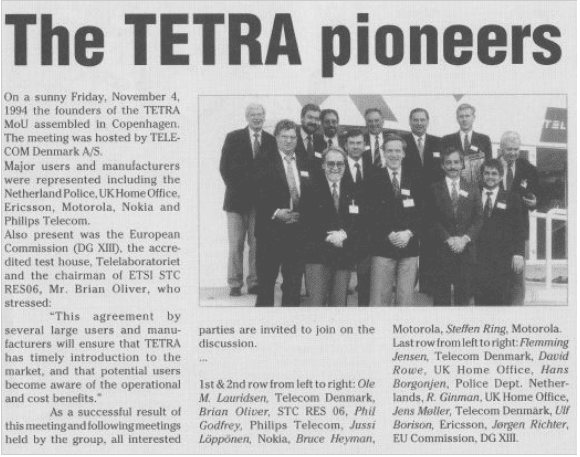Today is exactly 25 years ago that a group of critical communication stakeholders gathered in Copenhagen to draft and sign the TETRA Memorandum of Understanding (MoU). Those individuals and their companies became the founders of the TETRA MoU Association, now known as TCCA – The Critical Communications Association.
In those 25 years, TCCA has grown into a global organization that continues to promote the development of TETRA technology through its TETRA Industry Group and plays a role in developing critical broadband 4G / LTE and 5G standards. This is done through the status of TCCA’s Market Representation Partner in 3GPP, support for the ETSI MCX (Mission Critical Voice, Data and Video) Plugtests ™ and TCCA’s Broadband Industry and Critical Broadband Working Groups (BIG and CCBG).
The first meeting was held at the UK Home Office in London in February 1999 and the first IOP certificates were published in November 1999. 20 years later, the TETRA IOP process continues to lead the world in independent certification for critical communication.
TCCA’s IOP process has been developed to enable an open multi-vendor market for TETRA equipment and systems. This approach offers users clear benefits in terms of a broad portfolio of compatible equipment, competitive prices and rapid development of new product models. The IOP process also benefits the industry by creating a more accessible market, faster market introduction and greater potential for investment in new developments. TCCA’s IOP tests are conducted by an independent body, currently ISCOM, part of the Italian Ministry of Communications.
TCCA is now working with partners such as the Global Certification Forum (GCF) to develop and implement a global MCX interoperability testing and certification regime, and is working with an ever-wider range of industrial partners to promote critical communication worldwide.
25 years of excellence
Jeppe Jepsen was the director of TETRA at Motorola when the original MoU was signed, and developed the association and the critical communication market firsthand from 1994. “During these 25 years, the association has expanded the market to all parts of the world and all sectors of PMR / LMR. TCCA has developed into the critical communication broadband ecosystem to become the place where user organizations and industry can discuss and clarify their common problems, and to be the fair place to obtain and share information, ”said Jepsen.
“By lobbying governments and regulators, we have reached an international agreement on broadband spectrum for PPDR, and we have drafted and continued technology roadmap agreements in the supply and demand sectors.”
Tony Gray, TCCA Chief Executive, underlines the importance of collaboration between industry and users and the countless days of volunteer work to develop strict processes for the development of technical solutions. “This 25th anniversary is a new opportunity to publicly thank all our members, our partners and all supporters of excellence in critical communication. The impact that such a niche but crucial market has on the safety and security of the world cannot be underestimated, and we are proud that TCCA is firmly anchored in the centre of developments. “
The importance of standards
Brian Murgatroyd, president of the ETSI TC TCCE (Technical Committee TETRA and critical communication evolution), outlines the reasons why TETRA has been such a long-term success and the choice for users of critical communication.
“TETRA was conceived at a time when there was a need for reliable, secure and interoperable digital mobile radio services for professional users. This was achieved through the development of an open standard of really high quality and detail. It was produced by experts from various mobile radio companies and governments, who spent years of meticulous work and provided the options for a modern digital system that would offer many functions and services. An open standard has ensured good competition between manufacturers that has kept prices affordable and, above all, has encouraged continuous innovation, ”said Murgatroyd.
“The TETRA standard was first developed in the 1990s, but is still being improved today and is seen as a long-term future well into the 2030s and beyond. It now consists of more than 130 separate technical specifications and more than 35 technical reports and manuals. Although a good standard is the basis for success, this could not have happened without the cooperation of users, operators and manufacturers. That is why what is now called TCCA has been devised and has always had a very close relationship with ETSI and the TETRA standard. We are still developing the TETRA technology to ensure that it will still be fit for purpose over the next 20 years, but we have expanded our task with specifications for specifications for critical communication broadband services. In particular, we develop new interfaces to ensure successful interaction between TETRA networks and mission-critical broadband systems. We wish TCCA a great future for another 25 years. “

